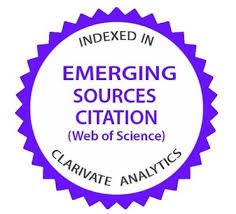Prácticas agrícolas, descripción morfológica, proteínica y culinaria del grano de cultivares de frijol sembrados en la región de Tlatzala, Guerrero
DOI:
https://doi.org/10.35197/rx.05.02.2009.05.fsPalabras clave:
Phaseolus vulgaris L., tecnología tradicional, caracteres del grano, contenido de proteínaResumen
La investigación tuvo por objeto describir el proceso productivo del cultivo de frijol en la comunidad de Tlatzala, Guerrero y la diversidad de la especie mediante las características morfológicas del grano, contenido de proteína y la calidad culinaria. Fueron aplicados 30 cuestionarios a productores de frijol y se colectaron 20 variedades criollas de las cuales se obtuvieron los caracteres morfológicos del grano, el contenido de proteína y los caracteres culinarios. El ciclo de producción de frijol inicia en mayo y finaliza en octubre. La tecnología utilizada es tradicional caracterizada por el uso de la yunta en las labores del cultivo que demanda mano de obra para realizar las actividades de forma manual. El ciclo biológico de las variedades comienza en junio, la variación en tiempo esta acotada por el genotipo cultivado. Los frijoles de mata o arbustivo son predominantes (65 %). Los sistemas de siembra son: intercalado (50 %) y asociado con maíz (30 %) y monocultivo (20 %). Las variedades Rojito y Blanco tienen usos especiales, la primera tiene el atributo de ser consumida en ejote durante todo el año y la segunda es utilizada para preparar el platillo de chile-ajo. Los frijoles negros son los más frecuentes (45 %) seguidos de los rojos (35 %) y los menos frecuentes fueron el rayado (5 %) y barroso (5 %). Las forma de grano arriñonada es la más abundante (85 %) y la ovalada la menos frecuente (5 %). El peso de grano varió desde 14.4 hasta 38.5 g. Los tamaños de granos encontrados fueron mediano (50 %) y pequeño (50
%). El contenido de proteína registrado fue: frijoles blancos
24.7 %, rojos 24.6 %, negros 23.5 % y Rayado de Guía 22.3
%. El Rojito Enano tuvo el mayor contenido de proteína (27.6 %). Los tiempos de cocción fueron: frijoles rojos 73 minutos, Rayado de Guía 65.5, negros 64.6 y blancos 59. El frijol Negro Enano-1 fue de cocción rápida (54 minutos). El frijol Rayado de Guía registró el mayor contenido de sólidos (0.32 %), seguido de los frijoles negros (0.25 %), rojos (0.24
%) y blancos (0.07 %). El Blanco Mediano-2 registró el menor contenido de sólidos (0.06 %). La mayor capacidad de absorción de agua se encontró en el frijol Rayado de Guía (123 %), continuaron los rojos (108 %), negros (99 %) y los blancos (95 %).
Descargas
Citas
Chemists. 14th Ed. Horwitz. W. (Ed). Washington, D.C. USA. 1141 p.
Bressani, R. 1985. Nutritive Value of frijol. In Singh, Sr., y Rachie, Ko. (Eds.), Cowpea Research, Productión and utilization (pp. 332-336). Wiley-New Jersey, EE. UU.
Brunner, B. R, y Beaver, J. S. 1989. Estimation of outcrossing of the common bean in Puerto Rico. Horticultural Science, 24, 669-671.
Castillo, M. M., Ramírez, V. P., Castillo, G. F., Miranda, C. S. 2006. Diversidad morfológica de poblaciones nativas de frijol común y frijol ayocote del Oriente del Estado de
México. Revista Fitotecnia Mexicana, 29 (2),
-119.
Cubero, S. J. I., Nadal, M. S., y Moreno Y. Ma. T. 2006. Recursos Fitogenéticos. Editorial Agrícola Española S. A., Ministerio de Agricultura, Pesca y Alimentación. España.
Díaz-Ruiz, R., Escalante-Estrada, J. A., Olalde- Gutierrez, V., y Herrera-Cabrera, E. 1999. Effect of maize on vean yield and its components in maize-bean intercropping. Annual Report of the Bean Improvement Cooperative, 42, 101-102.
Díaz-Ruiz, R., Ramírez-Pérez, A. R., y Paredes- Sánchez, J. A. 2008. Diversidad de semillas de frijol (Phaseolus vulgaris L.) cultivado en diferentes regiones del estado de Puebla. En
E. Reyes-Altamirano y J. A. Paredes-Sánchez (Coordinadores), Seguridad alimentaria en Puebla: prioridad para el desarrollo (pp. 225- 235). Secretaría de Desarrollo Rural del Gobierno del Estado de Puebla, Colegio de Postgraduados Campus Puebla. Editorial Altres Costa-Amic, México.
Díaz-Ruiz, R., Sandoval-Castro, E., y Herrera-Cabrera,
B. E. 2000. Efecto de la lombricomposta y fertilizante químico en frijol. En R. Quintero- Lizoala, T. Reyna-Trujillo, L. Corlay-Chee, A. Ibañez-Huerta, y N. E. García-Calderón (Eds.), La edafología y sus perspectivas al siglo XXI. Tomo II (pp. 577-581). Colegio de Postgraduados, Universidad Autónoma de México, Universidad Autónoma Chapíngo. México.
Guzmán, M. H., Jacinto, H. C., y Castellanos, Z. J. 1995. Manual de metodologías para evaluar calidad de grano de frijol (Tema didáctico No. 2). Secretaria de Agricultura, Ganadería y Desarrollo Rural (SAGARPA), INIFAP, Centro de Investigación Regional del Centro. México.
Herrera, C. B. E., Díaz-Ruiz, R., y Muñoz O. A. 1993. Variación genética en frijol (Phaseolus vulgaris L.) en la Cordillera del Tentzo, Puebla. En Memorias del I Simposio Internacional y II Reunión Nacional sobre Agricultura Sostenible: Importancia y contribución de la agricultura sostenible (pp. 193-198). Comisión de Estudios Ambientales, Centro de Enseñanza, Investigación y Capacitación para el Desarrollo Agrícola Regional, México.
Ibarra-Pérez, J. F., Ehdaie, B., y Waines G. 1997. Estimation of outcrossing rate in common bean. Crop Science, 37, 60-65.
–––––Internacional Board For Plant Genetic Resources (IBPGR). 1982. Phaseolus vulgaris Descriptors. Rome, Italy.
Kimani, J. M., y Tongoona P. 2008. The mechanism of genetic control for low soil nitrogen (N)
tolerance in common beans (Phaseolus vulgaris L.). Euphytica, 162, 193-2003.
Lépiz, I. R., y Rodríguez, G. E. 2006. Los recursos fitogenéticos de México. En M. J. C., Molina, y T. L. Córdova (Eds.), Recursos Fitogenéticos de México para la Alimentación y la Agricultura: Informe Nacional 2006 (pp. 1-17). Secretaría de Agricultura, Ganadería, Desarrollo Rural, Pesca y Alimentación, Sociedad Mexicana de Fitogenética A. C. Chapíngo, México.
Leterme, P., y Muñoz L. C. 2002. Factors Influencing pulse consumption in Latin América. British journal of Clinical Nutrition, 88 (Suppl. 3), 251-254.
Miranda C. S. 1991. Evolución de Phaseolus vulgaris y Phaseolus coccineus. En E. Mark Englaman (Ed.), Contribuciones al conocimiento del frijol (Phaseolus) en México (pp. 83-99). Colegio de Postgraduados. Chapingo, México.
Nadal, M. S., Moreno, Y. Ma. T., y Cubero S. J. I. 2004. Las leguminosas grano en la agricultura moderna. Mundi-Prensa. España.
Pérez, H. P., Ezquivel, E. G., Rosales, S. R., y Acosta,
G. J. A. 2002. Caracterización física, culinaria y nutricional de frijol del Altiplano Subhúmedo de México. Archivos Latinoamericano de Nutrición, 52 (2), 172-180.
Pérez, M. J., Ferrera, C. R., y García E. R. 1994. Diversidad Genética y Patología del frijol. Colegio de Postgraduados en ciencias agrícolas, México.
SAGARPA. 2006. Anuario Estadístico Agrícola 2006. Oficina estatal de Información para el Desarrollo Rural Sustentable (OEIDRUS). (En línea). Disponible en http://www.oeidrus- Guerrero.gob.mx.
Shiva, V. 2003. Cosecha robada. El secuestro del suministro mundial de alimentos. Ediciones Paidós Ibérica S. A. Barcelona, España.
Singh, S. P., Gutierrez, J. A., Molina, A., Urea, C., y Gepts P. 1991. Genetic diversity in cultivated common bean: II. Marker based analysis of morphological and agronomie traits. Crop Science, 31, 23-29.
Villalobos, F. J., Mateos, L., Orgaz, F., y Fereres, E. 2002. Fitotecnia: Bases y tecnologías de la producción agrícola. Mundi-Prensa. España.
Woolley, J. N. y Davis, H. C. J. 1988. Agronomía de cultivos asociados con fríjol. Centro Internacional de Agricultura Tropical. Cali, Colombia.
Descargas
Publicado
Cómo citar
Número
Sección
Licencia
Derechos de autor 2009 Fausto Solano Cervantes, Ramón Díaz Ruiz, Carmen Jacinto Hernández, Luciano Aguirre Álvarez , Arturo Huerta de la Peña

Esta obra está bajo una licencia internacional Creative Commons Atribución-NoComercial 4.0.
Usted es libre de:
- Compartir — copiar y redistribuir el material en cualquier medio o formato
- Adaptar — remezclar, transformar y construir a partir del material
- La licenciante no puede revocar estas libertades en tanto usted siga los términos de la licencia
Bajo los siguientes términos:
- Atribución — Usted debe dar crédito de manera adecuada , brindar un enlace a la licencia, e indicar si se han realizado cambios . Puede hacerlo en cualquier forma razonable, pero no de forma tal que sugiera que usted o su uso tienen el apoyo de la licenciante.
- NoComercial — Usted no puede hacer uso del material con propósitos comerciales .
- No hay restricciones adicionales — No puede aplicar términos legales ni medidas tecnológicas que restrinjan legalmente a otras a hacer cualquier uso permitido por la licencia.








